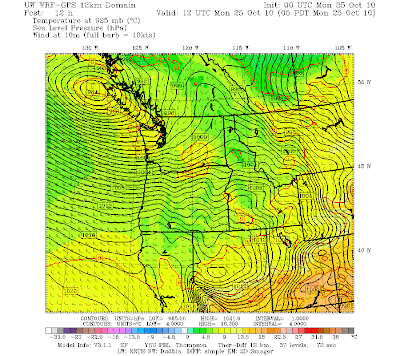
Is it possible that weather could influence the outcome of Tuesday's midterm election? If so, can we make any predictions based on current weather forecasts?
The general wisdom is that bad weather favors the Republicans since supposedly some key Democratic voting blocks (e.g., the elderly) are more weather sensitive than the rest of the population. Republicans are supposedly less influenced by rain for reasons that escape me.
It turns out that the academic literature is very thin on this topic and I could only find one refereed article in the Journal of Politics by Gomez, Hansford and Krause ("The Republicans Should Pray for Rain: Weather, Turnout, and Voting in U.S. Presidential Elections"
According to this paper, which examined turnout in 14 presidential elections using 22,000 weather stations, there ARE statistically significant results:
Heavy rain reduces voter turnout by roughly 1% for every inch of rain above normal. Snow reduces turnout by .5% per inch. Furthermore, Republican presidential candidates gain 2.5% of the vote for every inch of rain above normal, and .6% for every inch of snow.
Now an inch of rain is quite a bit of precipitation, only occurring during major storms (like Monday in the NW) or in thunderstorm areas.
Furthermore, these results were for presidential elections where people are generally highly engaged and motivated. What about midterm elections like Tuesday's? If we assume that people would be less excited than for presidential runs would one expect the influence of precipitation to be greater for this election?
And what about the influence of the greater proportion of absentee ballots and of extended balloting times (some places in the U.S. allow voting in the weeks before the election)?
These are serious and weighty questions.
So lets play politics.
Here is the forecast precipitation for 12-h on Tuesday ending at 5 PM PDT (8 AM PDT). Most of the U.S. will be rain free (good for Democrats) and the only area with serious rain is in the southeast (eastern Texas, Louisiana, and Mississippi). No serious snow across the lower 48 states.
 Are there any close races that could be turned? Here is a map by political expert Karl Rove on the U.S. Senate races. It appears that there are no senatorial races that are close in the rain areas--there is either no race or they are heavily Republican.
Are there any close races that could be turned? Here is a map by political expert Karl Rove on the U.S. Senate races. It appears that there are no senatorial races that are close in the rain areas--there is either no race or they are heavily Republican. Here are Tuesday's temperatures across the lower-48: mild conditions are expected.
Here are Tuesday's temperatures across the lower-48: mild conditions are expected.
Thus, Patty Murray will be favored by better weather than expected on Tuesday, since the heavy rains of Monday will be over by then--thus people will be more likely to mail those last-minute ballots (only Pierce County still has polling stations here in Washington State). Might she be saved by the rapid movement of tomorrow's pineapple express?
The same picture is generally true for the House races, the rain will be mainly over Republican strongholds.
If the conventional wisdom has any basis or if the the Gomez study is applicable, the the weather forecasts are generally favorable for the Democrats, although the impact will probably be small. But as Gomez et al state, some close races HAVE been determined by weather.

















































